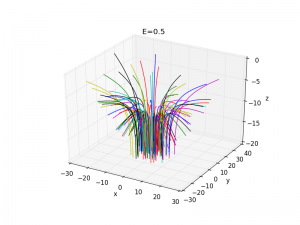A fun little man of rutherford scattering
So I coded up rutherford scattering in a real dumb way (you can significantly reduce your considerations by using symmetry and stuff).
I sort of monte carlo it with gaussian distributed initial conditions
import numpy as np
from scipy import integrate
z0 = -20.0
samples = 100
E=.5
t = np.linspace(0,50,100)
def F(x):
return .1 * x / np.linalg.norm(x)**1.5
def D(x,t):
return np.concatenate((x[3:],F(x[0:3])))
import matplotlib.pyplot as plt
from mpl_toolkits.mplot3d import Axes3D
fig = plt.figure()
ax = fig.add_subplot(111, projection='3d')
ax.set_xlabel('x')
ax.set_ylabel('y')
ax.set_zlabel('z')
def update(E):
ax.set_title('E='+str(E))
for i in range(samples):
initxy = 5*np.random.randn(2)
init = np.append(initxy,[z0, 0., 0., np.sqrt(E)])
sol = integrate.odeint(D, init, t)
ax.plot(sol[:,0], sol[:,1],sol[:,2])
update(E)
plt.show()
The bundles that come off look pretty cool
Lots that one could do with this. Compare the outgoing distribution to the formula, Try to discern shape of other potentials. Do a little statistics to see if charge or whatever can be determined from the data.
Show center of mass scattering. Try 4 particle scattering.
I guess I’m trying to play around in some high energy concepts.
